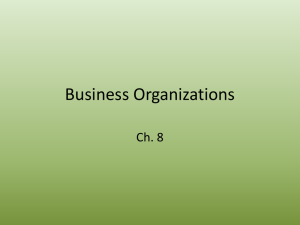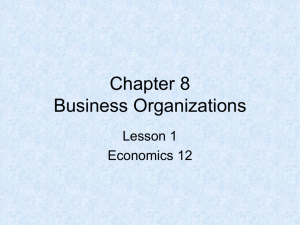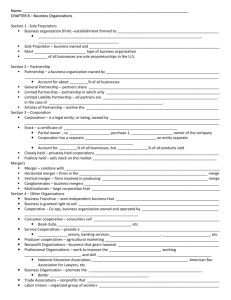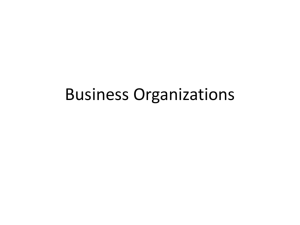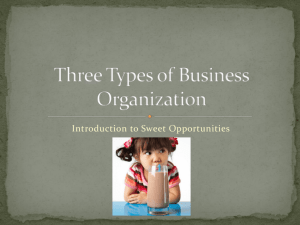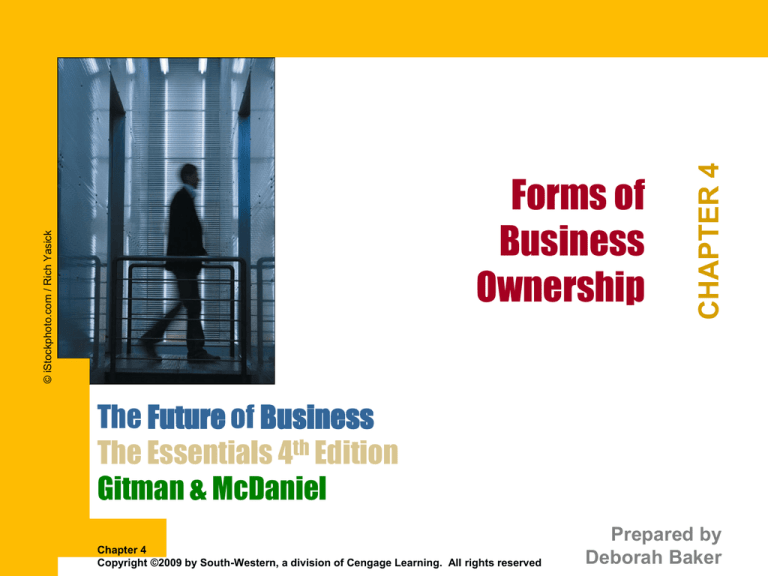
CHAPTER 4
© iStockphoto.com / Rich Yasick
Forms of
Business
Ownership
The Future of Business
The Essentials 4th Edition
Gitman & McDaniel
Chapter 4
Copyright ©2009 by South-Western, a division of Cengage Learning. All rights reserved
Prepared by
Deborah Baker
CHAPTER 4
Learning Goals
1 What are the advantages and disadvantages of
the sole proprietorship form of business
organization?
2 What are the advantages of operating as a
partnership, and what downside risks should
partners consider?
3 How does the corporate structure provide
advantages and disadvantages to a company,
and what are the major types of corporations?
2
CHAPTER 4
Learning Goals (continued)
4 What other options for business organization
does a company have in addition to sole
proprietorships, partnerships, and
corporations?
5 What makes franchising an appropriate form of
organization for some types of business, and
why does it continue to grow in importance?
6 Why are mergers and acquisitions important to
a company’s overall growth?
7 What current trends will affect the business
organizations of the future?
3
Business Ownership
Sole proprietorships
Partnerships
Corporations
4
Sole Proprietorships
1
1
What are the advantages and disadvantages
of the sole proprietorship form of
business organization?
5
Sole Proprietorships
sole proprietorship
A business that is established, owned, operated,
and often financed by one person.
1
6
Sole Proprietorships
Advantages
1
Easy and inexpensive
to form
Profits go to the owner
Direct control of the
business
Freedom from government
regulations
No special taxation
Ease of dissolution
Disadvantages
Unlimited liability
Difficulty raising capital
Limited managerial
expertise
Trouble finding
qualified employees
Personal time commitment
Unstable business life
Losses are owner’s
responsibility
7
CONCEPT check
What is a sole proprietorship?
Why is this a popular form of business
organization?
What are the drawbacks to being a
sole proprietor?
1
8
Partnerships
2
2
What are the advantages of operating
as a partnership, and what downside
risks should partners consider?
9
Partnerships
partnership
An association of two or more individuals who
agree to operate a business together for profit.
2
10
Partnerships
Advantages
2
Ease of formation
Availability of capital
Diversity of skills and
expertise
Flexibility
No special taxes
Relative freedom from
government control
Disadvantages
Unlimited liability
Potential for conflicts
between partners
Complexity of profit-sharing
Difficulty exiting or
dissolving partnership
11
CONCEPT check
How does a partnership differ from a sole
proprietorship?
Describe the three main types of partnerships
and explain the difference between a limited
partner and a general partner.
What are the main advantages and
disadvantages of a partnership?
2
12
Corporations
3
3
How does the corporate structure provide
advantages and disadvantages to a company,
and what are the major types of corporations?
13
Corporations
corporation
A legal entity with an existence and life separate from
its owners, who are not personally liable for the entity’s
debts.
A corporation is chartered by the state in which it is
formed and can own property, enter into contracts, sue
and be sued, and engage in business operations under
the terms of its charter.
3
14
The 10 Largest U.S. Corporations
1. Wal-Mart Stores
2. ExxonMobil
3. Chevron Texaco
4. General Motors
5. ConocoPhillips
6. General Electric
7. Ford Motor
8. Citigroup
9. Bank of America Corp.
Ranked by 2007 Sales
Source: “The 2008 Fortune 500,”
Fortune, http://money.cnn.com/magazines/fortune
(April 2008)
©Time Inc. All rights reserved.
10. AT&T
3
15
Articles of Incorporation
Name of corporation
Company’s goals
Types of stock and number of shares issued
Life of the corporation
Minimum investment by owners
Methods for transferring shares
Address of the corporate office
Names and addresses of the first board of directors
3
Exhibit 4.4
16
Corporations
Advantages
3
Limited liability
Ease of transferring
ownership
Unlimited life
Tax deductions
Ability to attract
financing
Disadvantages
Double taxation of
profits
Cost and complexity
of formation
More government
restrictions
17
Types of Corporations
3
C Corporation
A conventional or basic corporate form
of organization
S Corporation
A hybrid entity that is organized like a
corporation, but taxed like a partnership
Limited Liability
Company (LLC)
A hybrid organization that offers the
same liability protection as a corporation
but may be taxed as either a partnership
or a corporation
18
CONCEPT check
What is a corporation? Describe how corporations
are formed and structured.
Summarize the advantages and disadvantages of
corporations. Which features contribute to the
dominance of corporations in the business world?
Why do S corporations and limited liability
companies (LLCs) appeal to small businesses?
3
19
Specialized Forms of Business Organization
4
4
What other options for business organization
does a company have in addition to sole
proprietorships, partnerships, and corporations?
20
Specialized Forms of
Business Organization
cooperative
A legal entity typically formed by people with similar
interests, such as suppliers or customers, to reduce
costs and gain economic power.
A cooperative has:
limited liability
an unlimited life span
an elected board of directors
an administrative staff
profit distribution to member-owners
4
21
Cooperatives
4
Seller
Cooperatives
Individual producers join together
to compete more effectively with
large producers
Buyer
Cooperatives
A group of cooperative members
unite for combined purchasing
power
22
Benefits of Cooperatives
Empower people to improve their quality of life
Enhance economic opportunities through self-help
Provide members with services, including:
credit
finance
energy
consumer goods
housing
telecommunications
4
23
Cooperative Principles
4
Voluntary and open membership
Democratic member control
Member economic participation
Autonomy and independence
Education, training, and information
Cooperation among cooperatives
Concern for community
Source: “What Are Cooperatives,” Press Kit, National Cooperative Business Association, http://www.ncba.coop
Copyright ©NCBA. All rights reserved. Reproduced by permission.
24
Joint Ventures
joint venture
Two or more companies that form an alliance to pursue
a specific project usually for a specified time period.
4
25
CONCEPT check
Describe the two types of cooperatives and the
advantages of each.
What are the benefits of joint ventures?
4
26
Franchising
5
5
What makes franchising an appropriate form of
organization for some types of business, and why
does it continue to grow in importance?
27
Franchising
franchising
A form of business organization based on a business
arrangement between a franchisor, which supplies the
product concept and the franchisee, who sells the
goods or services of the franchisor in a certain
geographic area.
5
28
Top Franchises for 2008
1. 7-Eleven Inc.
2. Subway
3. Dunkin’ Donuts
4. Pizza Hut
5. McDonald’s
6. Sonic Drive In Restaurants
7. KFC Corp.
8. InterContinental Hotels Group
9. Domino’s Pizza LLC
10.RE/MAX Int’l. Inc.
5
Exhibit 4.8
Source: Top 10 Franchises in 2008 excerpted from “2008 Franchise 500 Rankings.”
Reprinted from http://entrepreneur.com/franchises/rankings/franchise500-115608/2008.html with permission of Entrepreneur.com, Inc.
Entrepreneur.com, Inc. All rights reserved.
29
Franchise Agreements
Franchisee
Agreement
Follow operating rules
Buy standard equipment
Keep up sales/service
levels
Take part in franchisor
promotions
Maintain a relationship
with franchisor
Franchisor
Agreement
5
Use of proven company
brand
Help finding a site
Building plans
Training and management
assistance
Managerial and accounting
procedures
Employee training
Wholesale prices for
supplies
Financial assistance
30
Franchises
Advantages
5
Increased ability for
franchisor to expand
Recognized name,
product, and operating
concept
Management training and
assistance
Financial assistance
Disadvantages
Loss of control
Cost of franchising
Restricted operating freedom
31
Franchise Purchase Tips
Act fast, yet proceed with caution
Put the franchisor to the test
Know what you’re getting into
Don’t invest more than you can afford to lose
Don’t fall in love with a trend
Exhibit 4.11
Source: Franchise Purchase Tips excerpted from “All the Rage—Tech & eBay.”
Reprinted from http://entrepreneur.com/magazine/entrepreneur/2005/January/74990 -2.html
with permission of Entrepreneur.com, Inc.
5
32
CONCEPT check
Describe franchising and the main parties
to the transaction.
Summarize the major advantages and
disadvantages of franchising.
Why has franchising proved so popular?
5
33
Mergers and Acquisitions
6
6
Why are mergers and acquisitions important
to a company’s overall growth?
34
Mergers and Acquisitions
merger
The combination of two or more firms to form a new
company, which often takes on a new corporate
identity.
6
35
Mergers and Acquisitions
acquisition
The purchase of a corporation by another corporation
or by an investor group; the identity of the acquired
company may be lost.
6
36
Merger Motives
Improve overall performance of the merged firms
through cost savings, elimination of overlapping
operations, improve purchasing power, increase
market share, or reduce competition.
6
Company growth
Broaden product lines
Acquire technology / skills
Acquire new markets
Financial restructuring:
cutting costs
selling off units
laying off employees
refinancing company
37
CONCEPT check
Differentiate between a merger and an acquisition.
What are the most common motives for corporate
mergers and acquisitions?
Describe the different types of corporate mergers.
6
38
Trends in Business Ownership
7
7
What current trends will affect the business
organizations of the future?
39
CONCEPT check
What are some of the demographic trends
currently impacting American business?
As a prospective business owner what could you
do to capitalize on these trends?
What other economic trends are influencing
today’s business organizations?
7
40


